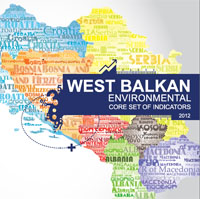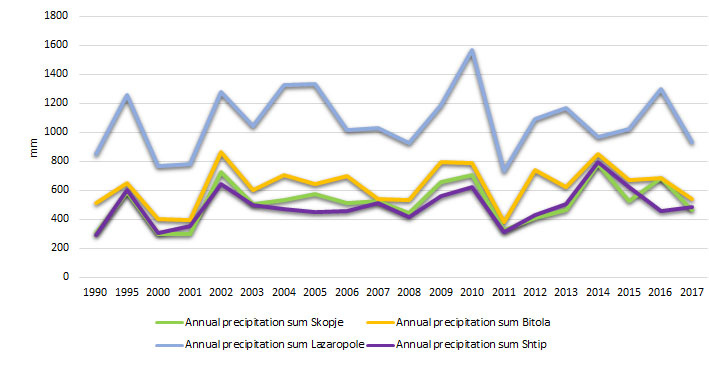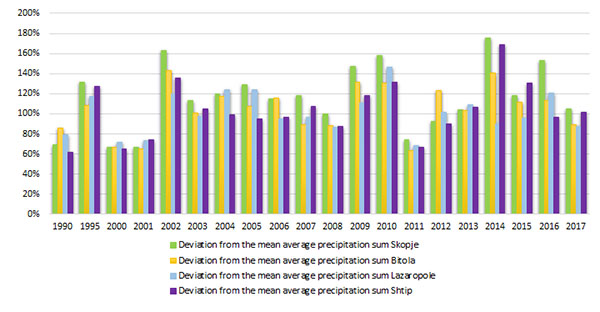| ATMOSPHERIC PRECIPITATIONS |
Indicator shows annual precipitation quantity fallen on a given area for a given period of time, in liquid or solid state and deviations of the annual precipitation sum from mean average precipitation over selected period of time on the whole national territory or in certain parts.
- millimeters (mm), percentage %, litre per square meter
What is the precipitation trend?
During the reporting period, variable trend was recorded in all four populated places. The annual deviations from the mean average precipitation for the period 1961 – 1990 ranged between 63% and143% in Bitola, between 62% and 169% in Shtip and between 72% and 124% in Lazaropole. In Skopje, annual deviation from the mean average precipitationfor the period 1981 to 1990 ranged between 67% and 176%.
Diagram 1. Trend in precipitations in selected populated places
Diagram 2. Deviations from long-term average precipitations in selected populated places
Data coverage: excel
Source of data: Hydrometeorological Administration, http://www.meteo.gov.mk/index.php?lang=en
The indicator takes into account data for annual precipitation sums from 1990 till 2017, mean average precipitation for the period 1961 to 1990 and deviation of the annual average precipitation sums.
The data processing was made for Bitola, the second major city, Lazaropole, place with the highestand Shtip with the lowest mean average precipitation sums for the period 1961-1990. For Skopje, the mean average precipitation was taken for the period 1981 to 1990.
In Skopje, the annual precipitation sum in 2017 was slightly increased by 5% compared to the mean average precipitation for the period 1981-1990. The wettest year was 2014 with annual precipitation of 782.9 mm and highest deviation from the mean average precipitation in the period 1981 – 1990 was also recorded this year reaching 76%.
In Bitola, the annualprecipitationin 2017 was decreased by 11.1% compared to the mean average precipitation sums for the period 1961-1990. The wettest year was 2002 with annual precipitation of 863.8 mm. The highest deviation from the mean average precipitation in the period from 1961 to 1990 was also recorded this year, reaching 43%.
In Shtip, the annualprecipitationin 2017 was slightly increased by 2% compared to the mean average precipitation sum for the period 1961-1990. The wettest year was 2014 with measured annual precipitation 799.4 mm. The highest deviation from the mean average precipitation in the period 1961-1990y was also recorded this year, reaching 69%.
In Lazaropole, the annual precipitationin 2017 was decreased by 13% compared to the mean average precipitation sum for the period 1961-1990. The wettest year was 2010 with measured annual precipitation 1566.5mm. The highest deviation from the mean average precipitation in the period 1961-1990 was also recorded this year, reaching 46%.
According to this indicator and the analyzed measuring sites it can be concluded that on the territory of Republic of Macedonia precipitation pattern is variable in space and time.
- Methodology for the indicator calculation
Precipitations are measured with: rain gauge, ombrometer (pluviometer) and with automatic precipitation sensor (at automatic meteorological stations). Instruments are positioned outdoors at 1 meter height. Rain gauge measures the overall precipitations accumulated during certain period of time. Time resolution can be 6 hours, 12 hours and 24 hours. In practice, daily sum of precipitations is usually operated with. Daily sum of precipitation means the quantity fallen during the period from 07 o’clock yesterday till 07 o’clock today.
Ombrometer is mechanical registration instrument recording the precipitation in time. Its minimum time resolution is between 1 and 10 minutes, depending on the type of the instrument.
Automatic sensor for precipitation is electronic sensor. It has alternating time resolution, starting from 1 minute.
Based on daily sum of precipitation, monthly, annual and mean average sums are calculated.
Data from ombrometer and automatic sensor enable calculation of precipitation intensity (precipitation quantity fallen in unit of time).
In the past, meteorological measurements in Skopje were characterized by frequent changes in location. The first meteorological measurementsdate back in 1924 (rainfall measuring station) and measurements as climatological stations started in 1944 in old Aerodrom (present location at Jane Sandanski Boulevard) and then the station was dislocated at the then airport Petrovec and now Alexander the Great. Meteorological station at Zajchev Rid was established in 1978 and has been operating with permanent measurements of meteorological elements and phenomena since then.
According to the surveys carried out in the sector for meteorology so far and results obtained, the Main meteorological station Skopje is more representative for Skopje Valley and wider urban area of the City of Skopje than the station at Alexander the Great airport the main purpose of which are the meteorological measurements for the aviation.
For the above reasons, we propose data from Skopje (Zajchev Rid) as the most relevant coming from a modern meteorological observatory. Based on the aforementioned, data on the long-term average precipitations for the City of Skopje was taken for the period 1981 to 1990.
Legal grounds
Law on Hydrometeorological Activity (Official Gazette of RM no.103/08, 53/11 and 51/15)
There are no targets defined
| Code | Title of the indicator | Compliance with CSI/EEA or other indicators | Classification by DPSIR | Type | Linkage with area | Frequency of publication | |
| MK NI 051 | Precipitations | CLIM 002 | Mean precipitation | I | А |
|
Annually |







































































